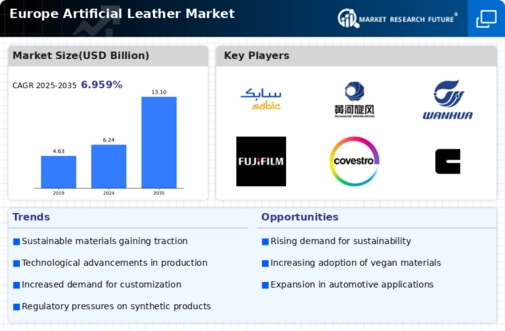The Europe Artificial Leather Market is marked by intense competitive dynamics as players strive to capitalize on increasing demand driven by eco-conscious consumer preferences, technological advancements, and expanding applications across various industries such as automotive, fashion, and home furnishings. Companies in this market are increasingly focusing on sustainability, innovation, and product differentiation to capture market share, responding to the growing trend for ethical and environmentally friendly materials.
The competitive landscape is characterized by established multinational corporations, rapidly evolving start-ups, and regional manufacturers, all vying for brand loyalty and market penetration through strategic partnerships, product launches, and investments in research and development. Moreover, market players are increasingly adopting digital transformation and advanced manufacturing technologies, enabling them to enhance their operational efficiency and product quality while meeting the demands for customizability and short lead times.SABIC stands out as a prominent player in the European Artificial Leather Market, leveraging its extensive knowledge in the chemical sector to deliver high-performance synthetic materials.
The company's dedication to research and development has resulted in innovative solutions tailored for specific applications, enhancing its competitive edge. SABIC’s strength lies in its robust supply chain capabilities and established relationships with clients across various sectors, which facilitate smooth market coverage and distribution in Europe. The company's commitment to sustainability is reflected in its initiatives to develop eco-friendly alternatives and its willingness to invest in green technologies.
Furthermore, SABIC’s inherent technical expertise enables it to cater to evolving customer preferences, thereby reinforcing its position as a leader in the synthetic materials domain within the European market.Huanghe Whirlwind has made a significant impact on the Europe Artificial Leather Market, establishing a strong presence through its diverse product offerings that include a wide range of synthetic leather types tailored for various uses, such as upholstery and fashion accessories. The company emphasizes quality and affordability, ensuring that its products meet the stringent regulations and standards set forth in the European region.
Huanghe Whirlwind enhances its market position through strategic partnerships and collaborations, expanding its distribution channels and fostering innovation in product development. The company's commitment to customer service and innovation has also resulted in a continuous stream of new product launches that appeal to a broad audience in Europe. Additionally, Huanghe Whirlwind has engaged in mergers and acquisitions to consolidate its market position, allowing it to enhance its operational capabilities and expand its competitive footprint within the European artificial leather landscape.























Leave a Comment